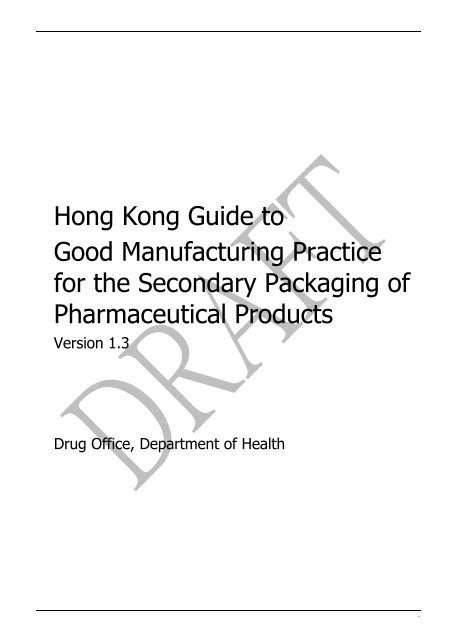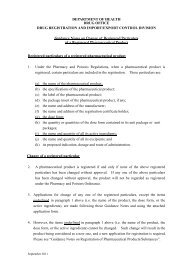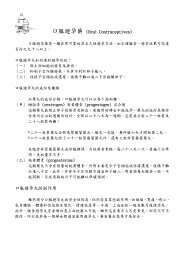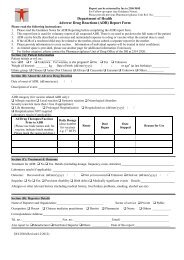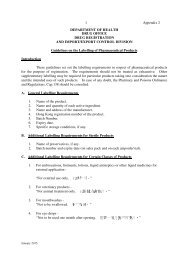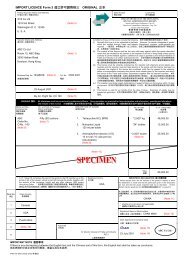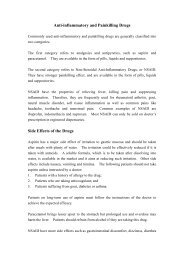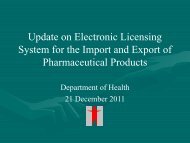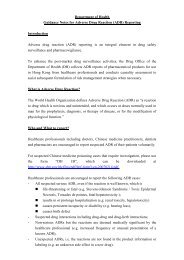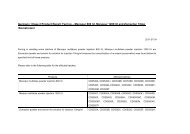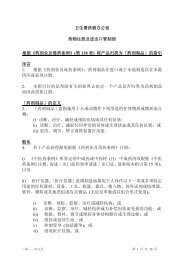Hong Kong Guide to Good Manufacturing Practice for the Secondary ...
Hong Kong Guide to Good Manufacturing Practice for the Secondary ...
Hong Kong Guide to Good Manufacturing Practice for the Secondary ...
Create successful ePaper yourself
Turn your PDF publications into a flip-book with our unique Google optimized e-Paper software.
<strong>Hong</strong> <strong>Kong</strong> <strong>Guide</strong> <strong>to</strong><br />
<strong>Good</strong> <strong>Manufacturing</strong> <strong>Practice</strong><br />
<strong>for</strong> <strong>the</strong> <strong>Secondary</strong> Packaging of<br />
Pharmaceutical Products<br />
Version 1.3<br />
Drug Office, Department of Health<br />
.
Contents list<br />
1. QUALITY MANAGEMENT............................................................................................. 4<br />
2. PERSONNEL................................................................................................................ 4<br />
3. PREMISES .................................................................................................................. 6<br />
4. MATERIALS CONTROL................................................................................................ 7<br />
5. GOOD PRACTICES IN SECONDARY PACKAGING ........................................................ 8<br />
6. QUALITY CONTROL .................................................................................................... 9<br />
7. DOCUMENTATION .................................................................................................... 10<br />
8. STOCK HANDLING AND STOCK CONTROL................................................................ 12<br />
9. REJECTED AND RETURNED GOODS.......................................................................... 12<br />
10. PRODUCT COMPLAINTS ........................................................................................... 13<br />
11. PRODUCT RECALL .................................................................................................... 13<br />
12. SELF INSPECTION .................................................................................................... 14<br />
13. CONTRACT PACKAGING OR ANALYSIS ARRANGEMENTS......................................... 14<br />
<strong>Hong</strong> <strong>Kong</strong> <strong>Guide</strong> <strong>to</strong> <strong>Good</strong> <strong>Manufacturing</strong> <strong>Practice</strong> <strong>for</strong> <strong>the</strong> <strong>Secondary</strong> Packaging of Pharmaceutical Products Page 2
PURPOSE OF THIS GUIDANCE<br />
This document serves <strong>to</strong> provide guidance <strong>to</strong> companies conducting secondary packaging but<br />
it is not meant <strong>to</strong> replace <strong>the</strong> PIC/S <strong>Guide</strong> <strong>to</strong> <strong>Good</strong> <strong>Manufacturing</strong> <strong>Practice</strong> <strong>for</strong> Medicinal<br />
Products. The PIC/S <strong>Guide</strong> <strong>to</strong> <strong>Good</strong> <strong>Manufacturing</strong> <strong>Practice</strong> <strong>for</strong> Medicinal Products would be<br />
<strong>the</strong> standard used during <strong>the</strong> GMP inspection of all manufacturers (including secondary<br />
packaging manufacturers) of pharmaceutical products.<br />
DEFINITION<br />
<strong>Secondary</strong> packaging is a manufacturing step and means <strong>the</strong> labelling, relabelling, car<strong>to</strong>ning,<br />
re-car<strong>to</strong>ning or adding additional in<strong>for</strong>mation (including inserts) <strong>to</strong> pharmaceutical products<br />
which are already enclosed in <strong>the</strong> container in which <strong>the</strong>y are <strong>to</strong> be sold or supplied.<br />
SCOPE<br />
This document applies <strong>to</strong> any company carrying out <strong>the</strong> secondary packaging of<br />
pharmaceutical products in <strong>Hong</strong> <strong>Kong</strong>.<br />
<strong>Secondary</strong> packaging operations involving <strong>the</strong> application of a supplementary label that does<br />
not obliterate, change or display in<strong>for</strong>mation relating <strong>to</strong> <strong>the</strong> original name, list of ingredients,<br />
dosage instructions, batch number or expiry date of <strong>the</strong> pharmaceutical product are exempted<br />
from <strong>the</strong> requirements of this <strong>Good</strong> <strong>Manufacturing</strong> <strong>Practice</strong> (GMP) <strong>Guide</strong>.<br />
Full compliance with <strong>the</strong> <strong>Hong</strong> <strong>Kong</strong> GMP <strong>Guide</strong>lines <strong>for</strong> Pharmaceutical Products applies <strong>to</strong><br />
packaging of a bulk product <strong>to</strong> become a finished product which involves <strong>the</strong> use of primary<br />
packaging materials. Primary packaging materials are packaging materials that are intended <strong>to</strong><br />
be in direct contact with <strong>the</strong> products.<br />
<strong>Hong</strong> <strong>Kong</strong> <strong>Guide</strong> <strong>to</strong> <strong>Good</strong> <strong>Manufacturing</strong> <strong>Practice</strong> <strong>for</strong> <strong>the</strong> <strong>Secondary</strong> Packaging of Pharmaceutical Products Page 3
1. QUALITY MANAGEMENT<br />
1.1 Companies carrying out secondary packaging of pharmaceutical products should<br />
establish and maintain a Quality System setting out responsibilities, organisational<br />
structure, resources, processes, procedures and o<strong>the</strong>r activities necessary <strong>to</strong> ensure<br />
confidence in <strong>the</strong> quality of <strong>the</strong> products released <strong>for</strong> supply after secondary packaging.<br />
1.2 The Quality System should be fully documented and its effectiveness moni<strong>to</strong>red on a<br />
regular basis. All Quality System related activities should be defined and documented. A<br />
Quality Manual or equivalent documentation approach should be established and<br />
maintained.<br />
1.3 Management should appoint a Quality Assurance Officer who should have defined<br />
responsibilities <strong>for</strong> ensuring that a Quality System is implemented and maintained.<br />
1.4 A system should be established and maintained <strong>to</strong> approve suppliers of packaging<br />
materials <strong>to</strong> be used in secondary packaging. In <strong>the</strong> case of critical materials such as<br />
printed packaging materials, <strong>the</strong> reliability of <strong>the</strong> suppliers may need <strong>to</strong> be verified by<br />
<strong>the</strong> Quality Assurance Officer conducting on-site audits.<br />
1.5 The Quality System should ensure that:<br />
a. Management responsibilities are clearly defined.<br />
b. A system of change control is in place <strong>to</strong> document and manage any changes that<br />
may impact <strong>the</strong> quality of <strong>the</strong> final product.<br />
c. Appropriate corrective and preventative actions (commonly known as CAPA) are<br />
taken (and documented) <strong>to</strong> correct deviations and prevent <strong>the</strong>ir re-occurrence.<br />
2. PERSONNEL<br />
Key Personnel<br />
2.1 Key personnel include Person in charge of secondary packaging and Quality Assurance<br />
Officer. They must be independent from each o<strong>the</strong>r. There should be a staff<br />
organisation chart showing this independence.<br />
2.2 The company should appoint a Person in charge of secondary packaging <strong>to</strong> be<br />
responsible <strong>for</strong> <strong>the</strong> following activities:<br />
a. Establish and maintain <strong>the</strong> company’s Quality System, and coordinate regular<br />
reviews of <strong>the</strong> effectiveness of <strong>the</strong> Quality System.<br />
b. Supervise <strong>the</strong> secondary packaging operations.<br />
c. Ensure that products are packaged and s<strong>to</strong>red according <strong>to</strong> <strong>the</strong> appropriate<br />
documentation in order <strong>to</strong> obtain <strong>the</strong> required quality.<br />
d. Approval of documentation and procedures relating <strong>to</strong> secondary packaging<br />
operations.<br />
e. Check <strong>the</strong> maintenance of premises and equipment.<br />
f. Coordination of self-inspections.<br />
g. Ensure that <strong>the</strong> required training of his department personnel is carried out and<br />
adapted according <strong>to</strong> need.<br />
2.3 The company should also appoint a Quality Assurance Officer <strong>to</strong> be responsible <strong>for</strong> <strong>the</strong><br />
following activities:<br />
a. Establish and maintain <strong>the</strong> company’s Quality System, and coordinate regular<br />
reviews of <strong>the</strong> effectiveness of <strong>the</strong> Quality System.<br />
<strong>Hong</strong> <strong>Kong</strong> <strong>Guide</strong> <strong>to</strong> <strong>Good</strong> <strong>Manufacturing</strong> <strong>Practice</strong> <strong>for</strong> <strong>the</strong> <strong>Secondary</strong> Packaging of Pharmaceutical Products Page 4
. Approval of products received <strong>for</strong> secondary packaging.<br />
c. Approval of packaging materials, including printed packaging materials, be<strong>for</strong>e <strong>the</strong>y<br />
are used in secondary packaging operations.<br />
d. Approval of documentation and procedures relating <strong>to</strong> quality control.<br />
e. Certification that each batch of pharmaceutical product that is subject <strong>to</strong> secondary<br />
packaging has been processed and controlled in accordance with <strong>the</strong> requirements<br />
set out in this guidance document be<strong>for</strong>e <strong>the</strong> batch is released <strong>for</strong> sale or supply.<br />
f. Establish and maintain a list of approved suppliers of packaging materials, including<br />
printed packaging materials, <strong>to</strong> be used in secondary packaging operations.<br />
g. Coordination of self-inspections.<br />
h. Coordination of <strong>the</strong> handling of complaints and recalls.<br />
i. Approval of contract agreements.<br />
j. Ensure that <strong>the</strong> required training of his department personnel is carried out and<br />
adapted according <strong>to</strong> need.<br />
Qualifications of Key Personnel<br />
2.4 The Person in charge of secondary packaging operations should have adequate<br />
academic qualification, sufficient experience in pharmaceutical manufacture and/or<br />
secondary packaging, and necessary knowledge in <strong>the</strong> principle of GMP, <strong>to</strong> enable an<br />
understanding of <strong>the</strong> risks associated with <strong>the</strong> activities being undertaken and <strong>the</strong><br />
regula<strong>to</strong>ry environment.<br />
2.5 The Quality Assurance Officer should have adequate academic qualification and <strong>the</strong><br />
necessary knowledge in <strong>the</strong> principles of GMP and legislation related <strong>to</strong> pharmaceutical<br />
products. This person should have sufficient experience in secondary packaging of<br />
pharmaceutical products and should have a clear understanding of <strong>the</strong> risks associated<br />
with <strong>the</strong> activities being undertaken in <strong>the</strong> regula<strong>to</strong>ry environment.<br />
Training<br />
2.6 Adequate training should be provided <strong>for</strong> all personnel whose activities could affect <strong>the</strong><br />
quality of <strong>the</strong> final products. Training programs should be available and its practical<br />
effectiveness should be periodically assessed. Records of training provided <strong>to</strong> personnel<br />
should be maintained.<br />
Personal Hygiene<br />
2.7 Every person entering <strong>the</strong> secondary packaging area(s) should wear protective garments<br />
appropriate <strong>to</strong> <strong>the</strong> operations <strong>to</strong> be carried out which includes at least a hair cover and<br />
clean protective garments.<br />
2.8 Eating, drinking, chewing or smoking, or <strong>the</strong> s<strong>to</strong>rage of food, drink, smoking materials or<br />
personal medication in <strong>the</strong> packaging and s<strong>to</strong>rage areas should be prohibited. In general,<br />
any unhygienic practice within <strong>the</strong> packaging areas or in any o<strong>the</strong>r area where <strong>the</strong><br />
product might be adversely affected should be <strong>for</strong>bidden.<br />
2.9 Visi<strong>to</strong>rs or untrained personnel should, preferably, not be taken in<strong>to</strong> <strong>the</strong> secondary<br />
packaging area(s). If this is unavoidable, <strong>the</strong>y should be given in<strong>for</strong>mation in advance,<br />
particularly about personal hygiene and <strong>the</strong> prescribed protective clothing. They should<br />
be closely supervised.<br />
<strong>Hong</strong> <strong>Kong</strong> <strong>Guide</strong> <strong>to</strong> <strong>Good</strong> <strong>Manufacturing</strong> <strong>Practice</strong> <strong>for</strong> <strong>the</strong> <strong>Secondary</strong> Packaging of Pharmaceutical Products Page 5
3. PREMISES<br />
3.1 Premises used <strong>for</strong> secondary packaging should be specifically designed, constructed and<br />
laid out <strong>to</strong> avoid product mix-up and cross-contamination.<br />
3.2 The size of <strong>the</strong> secondary packaging area(s) should reflect <strong>the</strong> volume of work involved.<br />
The adequacy of <strong>the</strong> working space or work bench <strong>for</strong> secondary packaging should<br />
permit <strong>the</strong> orderly and logical positioning of equipment and materials so as <strong>to</strong> avoid<br />
confusion and <strong>to</strong> minimize <strong>the</strong> risk of mix-up between different pharmaceutical products<br />
and <strong>the</strong>ir components.<br />
3.3 <strong>Secondary</strong> packaging areas and associated s<strong>to</strong>rage areas should be well-lit and<br />
effectively ventilated, with air control facilities (including temperature and, where<br />
necessary, humidity and filtration) appropriate both <strong>to</strong> <strong>the</strong> products handled and <strong>to</strong> <strong>the</strong><br />
operations undertaken within <strong>the</strong>m. Temperature and humidity should be moni<strong>to</strong>red<br />
regularly, and record made in a logbook.<br />
3.4 There should be adequate s<strong>to</strong>rage areas with general good housekeeping. The s<strong>to</strong>rage<br />
areas should be designed and equipped <strong>to</strong> prevent <strong>the</strong> entry of insects, rodents and<br />
o<strong>the</strong>r animals.<br />
3.5 There should be a pest control program <strong>to</strong> control <strong>the</strong> entry of insects, rodents and<br />
o<strong>the</strong>r animals. Appropriate records should be kept.<br />
3.6 Segregated areas should be provided <strong>for</strong> <strong>the</strong> s<strong>to</strong>rage of approved, quarantined, rejected,<br />
recalled and returned materials or products.<br />
3.7 Rest and refreshment rooms should be separate from <strong>the</strong> secondary packaging area(s).<br />
3.8 Adequate <strong>to</strong>ilet facilities should be available and should be kept clean and in good order.<br />
Toilets should not open directly in<strong>to</strong> <strong>the</strong> secondary packaging area(s).<br />
3.9 Premises should be cleaned and, where applicable, disinfected according <strong>to</strong> detailed<br />
written procedures. Appropriate records should be kept.<br />
<strong>Hong</strong> <strong>Kong</strong> <strong>Guide</strong> <strong>to</strong> <strong>Good</strong> <strong>Manufacturing</strong> <strong>Practice</strong> <strong>for</strong> <strong>the</strong> <strong>Secondary</strong> Packaging of Pharmaceutical Products Page 6
4. MATERIALS CONTROL<br />
Products subject <strong>to</strong> <strong>Secondary</strong> Packaging<br />
4.1 For each delivery of pharmaceutical product received <strong>for</strong> secondary packaging, <strong>the</strong><br />
containers should be checked <strong>for</strong> identity, integrity of package and seal, and<br />
correspondence between <strong>the</strong> delivery note and <strong>the</strong> supplier’s labels, and <strong>for</strong> compliance<br />
with product quality specifications.<br />
4.2 Pharmaceutical products held in <strong>the</strong> s<strong>to</strong>rage area should be appropriately labelled. There<br />
should be appropriate procedures or measures <strong>to</strong> assure <strong>the</strong> identity of <strong>the</strong> contents of<br />
each container of <strong>the</strong> products.<br />
4.3 All pharmaceutical products should be s<strong>to</strong>red under <strong>the</strong> appropriate conditions<br />
established by <strong>the</strong> manufacturer and in an orderly fashion <strong>to</strong> permit batch segregation<br />
and s<strong>to</strong>ck rotation.<br />
4.4 Those products requiring special s<strong>to</strong>rage conditions (<strong>for</strong> example specific temperature<br />
and humidity conditions) should be placed in separate areas constructed and equipped<br />
<strong>to</strong> provide <strong>the</strong> specified conditions. The s<strong>to</strong>rage conditions should be continuously<br />
moni<strong>to</strong>red and recorded.<br />
Packaging Materials<br />
4.5 Materials <strong>to</strong> be used in secondary packaging, including printed packaging materials,<br />
should only be obtained from approved suppliers named in <strong>the</strong> relevant specification <strong>for</strong><br />
that material.<br />
4.6 Each delivery or batch of labels and printed packaging materials received should be<br />
examined and approved by <strong>the</strong> Quality Assurance Officer, and given a specific reference<br />
number <strong>for</strong> traceability purposes. Only starting materials which have been released by<br />
<strong>the</strong> Quality Assurance Officer should be used.<br />
4.7 Particular attention should be given <strong>to</strong> <strong>the</strong> handling and control of labels and printed<br />
packaging materials, including <strong>the</strong> need <strong>for</strong> <strong>the</strong>m <strong>to</strong> be:<br />
a. Purchased from approved suppliers named in <strong>the</strong> relevant specification.<br />
b. S<strong>to</strong>red in adequately secure conditions such as <strong>to</strong> exclude unauthorized access.<br />
c. S<strong>to</strong>red in separate, closed containers so as <strong>to</strong> avoid mix-ups.<br />
d. Issued <strong>for</strong> use only by authorized personnel following an approved and documented<br />
procedure.<br />
e. Transported <strong>to</strong> <strong>the</strong> secondary packaging area in separate, closed containers so as <strong>to</strong><br />
avoid mix-ups.<br />
4.8 Out-dated or obsolete printed packaging material should be destroyed and <strong>the</strong>ir disposal<br />
recorded.<br />
<strong>Hong</strong> <strong>Kong</strong> <strong>Guide</strong> <strong>to</strong> <strong>Good</strong> <strong>Manufacturing</strong> <strong>Practice</strong> <strong>for</strong> <strong>the</strong> <strong>Secondary</strong> Packaging of Pharmaceutical Products Page 7
5. GOOD PRACTICES IN SECONDARY PACKAGING<br />
5.1 The appropriate registered particulars of <strong>the</strong> pharmaceutical products that are subject <strong>to</strong><br />
secondary packaging should be complied with and, where necessary, <strong>the</strong> approval of <strong>the</strong><br />
holder of <strong>the</strong> Certificate of Drug/Product Registration should be sought if <strong>the</strong>re is any<br />
variation <strong>to</strong> <strong>the</strong> registered particulars.<br />
5.2 When setting up a program <strong>for</strong> <strong>the</strong> secondary packaging operations, particular attention<br />
should be given <strong>to</strong> minimizing <strong>the</strong> risk of cross-contamination, mix-ups or substitutions.<br />
The secondary packaging of different products should not be carried out in close<br />
proximity unless <strong>the</strong>re is physical segregation.<br />
5.3 Special care should be taken when using cut-labels and when over-printing is carried out<br />
off-line. Roll-feed labels are preferable <strong>to</strong> cut-labels in helping <strong>to</strong> avoid mix-ups.<br />
5.4 Written procedures should be available <strong>for</strong> <strong>the</strong> handling of any spillage or breakage<br />
involving pharmaceutical products containing highly active substances (e.g. cy<strong>to</strong><strong>to</strong>xics,<br />
steroids, hormones, etc.) or highly sensitising substances (e.g. penicillins,<br />
cephalosporins, etc.).<br />
5.5 All products and materials used <strong>for</strong> secondary packaging operations should be checked<br />
be<strong>for</strong>e use by a designated person <strong>for</strong> quantity, identity and con<strong>for</strong>mity with <strong>the</strong><br />
Packaging Instructions.<br />
5.6 Line clearance checks should be per<strong>for</strong>med prior <strong>to</strong> commencement of each secondary<br />
packaging operation. Steps should be taken <strong>to</strong> ensure that <strong>the</strong> working area, packaging<br />
lines, printing machines and o<strong>the</strong>r equipment are clean and free from any products,<br />
materials or documents previously used, if <strong>the</strong>se are not required <strong>for</strong> <strong>the</strong> current<br />
operation.<br />
5.7 Each batch of product produced must be assigned a unique batch number which may<br />
incorporate <strong>the</strong> original manufacturer’s batch number and a suffix <strong>to</strong> identify each<br />
separate packaging run. Alternative batch numbering systems that provide full<br />
traceability <strong>to</strong> each packaging run may be accepted.<br />
5.8 The correct per<strong>for</strong>mance of any printing operation (<strong>for</strong> example batch number coding<br />
and expiry dating) should be checked and recorded. Attention should be paid <strong>to</strong> printing<br />
by hand which should be re-checked at regular intervals.<br />
5.9 Printed and embossed in<strong>for</strong>mation on packaging materials should be distinct and<br />
resistant <strong>to</strong> fading or erasing.<br />
5.10 On-line control of <strong>the</strong> product during secondary packaging should, where applicable,<br />
include checking <strong>the</strong> following:<br />
a. General appearance of packages.<br />
b. Completeness of packages.<br />
c. Correctness of products and packaging materials used.<br />
d. Correctness of over-printing, e.g. batch number, expiry date.<br />
e. Correctness of supplementary labels applied <strong>to</strong> products.<br />
5.11 Any deviation from instructions or procedures should be avoided as far as possible. If a<br />
deviation occurs, it should be approved in writing by <strong>the</strong> Quality Assurance Officer.<br />
5.12 Any significant or unusual discrepancy observed during reconciliation of <strong>the</strong> amount of<br />
printed packaging materials used and <strong>the</strong> number of units produced should be<br />
investigated and satisfac<strong>to</strong>rily accounted <strong>for</strong> be<strong>for</strong>e release <strong>for</strong> sale or supply.<br />
5.13 Upon completion of a secondary packaging operation, any unused batch-coded<br />
packaging materials should be destroyed and <strong>the</strong>ir destruction recorded. A documented<br />
procedure should be followed if un-coded printed materials are returned <strong>to</strong> s<strong>to</strong>ck.<br />
<strong>Hong</strong> <strong>Kong</strong> <strong>Guide</strong> <strong>to</strong> <strong>Good</strong> <strong>Manufacturing</strong> <strong>Practice</strong> <strong>for</strong> <strong>the</strong> <strong>Secondary</strong> Packaging of Pharmaceutical Products Page 8
5.14 Finished products should be held under quarantine and s<strong>to</strong>red under suitable conditions<br />
until <strong>the</strong>ir final release.<br />
6. QUALITY CONTROL<br />
6.1 There should be a designated and independent person in charge of Quality Control (QC).<br />
This may be <strong>the</strong> Quality Assurance Officer or ano<strong>the</strong>r, independent person.<br />
6.2 The identity, au<strong>the</strong>nticity and quality of each batch of pharmaceutical product that is <strong>to</strong><br />
be <strong>the</strong> subject of secondary packaging should be verified upon receipt by visual<br />
examination of <strong>the</strong> products and check against documentation such as delivery notes,<br />
certificates of analysis, established specifications, as well as <strong>the</strong> integrity of<br />
packaging/seals. These checks should be documented.<br />
6.3 If a valid certificate of analysis is not available <strong>for</strong> a batch of pharmaceutical product, it<br />
should be tested <strong>for</strong> compliance with established specifications by an appropriately<br />
accredited labora<strong>to</strong>ry be<strong>for</strong>e it is approved <strong>for</strong> secondary packaging.<br />
6.4 Where unlabelled containers of pharmaceutical products are received <strong>for</strong> secondary<br />
packaging, <strong>the</strong> identity of each batch should be verified by representative samples<br />
tested by an appropriately accredited labora<strong>to</strong>ry using specific chemical or instrumental<br />
techniques (irrespective of <strong>the</strong> availability of a certificate of analysis <strong>for</strong> <strong>the</strong> batch).<br />
Fur<strong>the</strong>rmore, unlabelled containers of pharmaceutical products should be subject <strong>to</strong><br />
secondary packaging in a single packaging run <strong>to</strong> minimise <strong>the</strong> risk of mix-up of<br />
remaining unlabelled containers.<br />
6.5 The identity and quality of packaging materials <strong>to</strong> be used in secondary packaging,<br />
including printed packaging materials, should be verified against established<br />
specifications. These checks should be documented.<br />
6.6 Finished product assessment should embrace all relevant fac<strong>to</strong>rs, including production<br />
conditions, results of in-process testing, a review of packaging documentation,<br />
compliance with finished product specification and examination of <strong>the</strong> final finished pack.<br />
6.7 Reference samples should be representative of <strong>the</strong> batch of materials or products from<br />
which <strong>the</strong>y are taken and should be of a size sufficient <strong>to</strong> permit at least a full reexamination.<br />
6.8 Reference sample and/or retention samples from each batch of finished products should<br />
be retained till one year after <strong>the</strong> expiry date. Finished product retention samples should<br />
be kept in <strong>the</strong>ir final packaging and s<strong>to</strong>red under <strong>the</strong> recommended conditions. Where a<br />
batch is packaged in two, or more, distinct packaging operations, at least one retention<br />
sample should be taken from each individual secondary packaging operation.<br />
6.9 Measuring, weighing, recording and control equipment should be calibrated and checked<br />
at defined intervals by appropriate methods. Adequate records of such tests should be<br />
maintained.<br />
<strong>Hong</strong> <strong>Kong</strong> <strong>Guide</strong> <strong>to</strong> <strong>Good</strong> <strong>Manufacturing</strong> <strong>Practice</strong> <strong>for</strong> <strong>the</strong> <strong>Secondary</strong> Packaging of Pharmaceutical Products Page 9
7. DOCUMENTATION<br />
General Requirements<br />
7.1 Documents should be designed, prepared, reviewed and distributed with care. They<br />
should comply with <strong>the</strong> relevant statu<strong>to</strong>ry requirements <strong>for</strong> licensed manufacturers and<br />
holders of <strong>the</strong> Certificate of Drug/Product Registration.<br />
7.2 Documents should be approved, signed and dated by appropriate and authorised<br />
persons.<br />
7.3 Documents should have unambiguous contents; title, nature and <strong>the</strong> purpose should be<br />
clearly stated. They should be laid out in an orderly fashion and be easy <strong>to</strong> check.<br />
Reproduced documents should be clear and legible. The reproduction of working<br />
documents from master documents must not allow any error <strong>to</strong> be introduced through<br />
<strong>the</strong> reproduction process.<br />
7.4 Documents should be regularly reviewed and kept up-<strong>to</strong>-date. When a document has<br />
been revised, systems should be operated <strong>to</strong> prevent inadvertent use of superseded<br />
documents.<br />
7.5 Documents should not be hand-written; although, where documents require <strong>the</strong> entry of<br />
data, <strong>the</strong>se entries may be made in clear, legible, indelible handwriting. Sufficient space<br />
should be provided <strong>for</strong> such entries.<br />
7.6 Any alteration made <strong>to</strong> <strong>the</strong> entry on a document should be signed and dated; <strong>the</strong><br />
alteration should permit <strong>the</strong> reading of <strong>the</strong> original in<strong>for</strong>mation. Where appropriate, <strong>the</strong><br />
reason <strong>for</strong> <strong>the</strong> alteration should be recorded.<br />
7.7 The records should be made or completed at <strong>the</strong> time each action is taken and in such a<br />
way that all significant activities concerning <strong>the</strong> packaging of pharmaceutical products<br />
are traceable.<br />
7.8 Batch documentation must be kept <strong>for</strong> one year after <strong>the</strong> expiry of <strong>the</strong> batch <strong>to</strong> which it<br />
relates or at least five years after certification of <strong>the</strong> batch by <strong>the</strong> Quality Assurance<br />
Officer, whichever is <strong>the</strong> longer.<br />
7.9 Data may be recorded by electronic data processing systems, pho<strong>to</strong>graphic or o<strong>the</strong>r<br />
reliable means, but detailed procedures relating <strong>to</strong> <strong>the</strong> system in use should be available<br />
and <strong>the</strong> accuracy of <strong>the</strong> records should be checked. If documentation is handled by<br />
electronic data processing methods, only authorised persons should be able <strong>to</strong> enter or<br />
modify data in <strong>the</strong> computer and <strong>the</strong>re should be a record of changes and deletions;<br />
access should be restricted by passwords or o<strong>the</strong>r means and <strong>the</strong> result of entry of<br />
critical data should be independently checked. Batch records electronically s<strong>to</strong>red should<br />
be protected by back-up transfer on magnetic tape, microfilm, paper or o<strong>the</strong>r means. It<br />
is particularly important that <strong>the</strong> data are readily available throughout <strong>the</strong> period of<br />
retention.<br />
<strong>Secondary</strong> Packaging Documents<br />
7.10 All packaging materials used in secondary packaging operations should have approved<br />
specifications which serve as <strong>the</strong> basis <strong>for</strong> quality evaluation by <strong>the</strong> Quality Assurance<br />
Officer upon <strong>the</strong>ir receipt.<br />
7.11 Written receipt, release and rejection procedures should be available <strong>for</strong> materials and<br />
products, and in particular <strong>for</strong> <strong>the</strong> release <strong>for</strong> sale or supply of <strong>the</strong> finished product by<br />
<strong>the</strong> Quality Assurance Officer. Records of receipt, release and rejection should be<br />
maintained <strong>for</strong> materials and products.<br />
<strong>Hong</strong> <strong>Kong</strong> <strong>Guide</strong> <strong>to</strong> <strong>Good</strong> <strong>Manufacturing</strong> <strong>Practice</strong> <strong>for</strong> <strong>the</strong> <strong>Secondary</strong> Packaging of Pharmaceutical Products Page 10
Packaging Instructions<br />
7.12 There should be <strong>for</strong>mally authorised Packaging Instructions <strong>for</strong> each product, pack size<br />
and type. These should normally include, or have a reference <strong>to</strong>, <strong>the</strong> following:<br />
a. name of <strong>the</strong> product;<br />
b. description of its pharmaceutical <strong>for</strong>m, and strength where applicable;<br />
c. <strong>the</strong> pack size expressed in terms of <strong>the</strong> number, weight or volume of <strong>the</strong> product in<br />
<strong>the</strong> final container;<br />
d. a complete list of all <strong>the</strong> packaging materials required, including quantities, sizes<br />
and types, with <strong>the</strong> code or reference number relating <strong>to</strong> <strong>the</strong> specifications of each<br />
packaging material;<br />
e. where appropriate, an example or reproduction of <strong>the</strong> relevant printed packaging<br />
materials, and specimens indicating where <strong>to</strong> apply batch number references, and<br />
shelf-life of <strong>the</strong> product;<br />
f. checks that <strong>the</strong> equipment and work station are clear of previous products,<br />
documents or materials not required <strong>for</strong> <strong>the</strong> planned packaging operations (line<br />
clearance), and that equipment is clean and suitable <strong>for</strong> use;<br />
g. special precautions <strong>to</strong> be observed, including a careful examination of <strong>the</strong> area and<br />
equipment in order <strong>to</strong> ascertain <strong>the</strong> line clearance be<strong>for</strong>e operations begin;<br />
h. a description of <strong>the</strong> packaging operation, including any significant subsidiary<br />
operations, and equipment <strong>to</strong> be used; and<br />
i. details of in-process controls with instructions <strong>for</strong> sampling and acceptance limits.<br />
Batch Packaging Records<br />
7.13 A Batch Packaging Record should be kept <strong>for</strong> each batch or part batch processed. It<br />
should be based on <strong>the</strong> relevant parts of <strong>the</strong> Packaging Instructions.<br />
The batch packaging record should contain <strong>the</strong> following in<strong>for</strong>mation:<br />
a. <strong>the</strong> name and batch number of <strong>the</strong> product;<br />
b. <strong>the</strong> date(s) and times of <strong>the</strong> packaging operations;<br />
c. identification (initials) of <strong>the</strong> opera<strong>to</strong>r(s) who per<strong>for</strong>med each significant step of <strong>the</strong><br />
process and, where appropriate, <strong>the</strong> name of any person who checked <strong>the</strong>se<br />
operations;<br />
d. records of checks <strong>for</strong> identity and con<strong>for</strong>mity with <strong>the</strong> Packaging Instructions<br />
including <strong>the</strong> results of in-process controls;<br />
e. details of <strong>the</strong> packaging operations carried out, including references <strong>to</strong> equipment<br />
and <strong>the</strong> packaging lines used;<br />
f. samples of printed packaging materials used, including specimens of <strong>the</strong> batch<br />
coding, expiry dating and any additional overprinting;<br />
g. notes on any special problems or unusual events including details, with signed<br />
authorisation <strong>for</strong> any deviation from <strong>the</strong> Packaging Instructions;<br />
h. <strong>the</strong> quantities and reference number or identification of all printed packaging<br />
materials and bulk product issued, used, destroyed or returned <strong>to</strong> s<strong>to</strong>ck and <strong>the</strong><br />
quantities of obtained product, in order <strong>to</strong> provide <strong>for</strong> an adequate reconciliation.<br />
Where <strong>the</strong>re are robust electronic controls in place during packaging <strong>the</strong>re may be<br />
justification <strong>for</strong> not including this in<strong>for</strong>mation;<br />
i. approval by <strong>the</strong> person responsible <strong>for</strong> <strong>the</strong> packaging operations.<br />
<strong>Hong</strong> <strong>Kong</strong> <strong>Guide</strong> <strong>to</strong> <strong>Good</strong> <strong>Manufacturing</strong> <strong>Practice</strong> <strong>for</strong> <strong>the</strong> <strong>Secondary</strong> Packaging of Pharmaceutical Products Page 11
8. STOCK HANDLING AND STOCK CONTROL<br />
S<strong>to</strong>ck Rotation and Control<br />
8.1 Comprehensive records should be maintained showing all receipt and issue of products<br />
(<strong>for</strong> secondary packaging) according <strong>to</strong> batch number.<br />
8.2 Periodic s<strong>to</strong>ck reconciliation should be per<strong>for</strong>med comparing <strong>the</strong> actual and recorded<br />
s<strong>to</strong>cks. In any event, this should be per<strong>for</strong>med when each batch is <strong>to</strong>tally used up. All<br />
significant s<strong>to</strong>ck discrepancies should be subjected <strong>to</strong> investigation as a check against<br />
inadvertent mix-ups and wrong issues.<br />
8.3 The issue of products <strong>for</strong> secondary packaging should normally observe <strong>the</strong> principle of<br />
s<strong>to</strong>ck rotation, i.e. first-in-first-out.<br />
8.4 Products with broken seals, damaged packaging or suspected of possible contamination<br />
must not be sold or supplied.<br />
8.5 <strong>Good</strong>s bearing an expiry date must not be received or supplied after <strong>the</strong>ir expiry date or<br />
so close <strong>to</strong> <strong>the</strong>ir expiry date that this date is likely <strong>to</strong> occur be<strong>for</strong>e <strong>the</strong> goods are used by<br />
<strong>the</strong> cus<strong>to</strong>mer.<br />
8.6 All labels and containers of products should not be altered, tampered or changed. The<br />
legislative requirements relating <strong>to</strong> labels and containers <strong>for</strong> pharmaceutical products<br />
should be complied with at all times.<br />
Delivery of Finished Products<br />
8.7 Be<strong>for</strong>e delivery, each consignment should be checked against <strong>the</strong> relevant<br />
documentation and physically verified by label description, type and quantity, against<br />
<strong>the</strong> order.<br />
8.8 Records should be maintained of <strong>the</strong> distribution of each batch of <strong>the</strong> product packaged<br />
in order <strong>to</strong> facilitate <strong>the</strong> recall of <strong>the</strong> batch if necessary.<br />
9. REJECTED AND RETURNED GOODS<br />
Rejected <strong>Good</strong>s<br />
9.1 Rejected materials and products should be clearly marked as being rejected and s<strong>to</strong>red<br />
separately in a locked area with restricted access. They should be ei<strong>the</strong>r returned <strong>to</strong> <strong>the</strong><br />
suppliers or destroyed. Whatever action is taken should be recorded and approved by<br />
<strong>the</strong> Quality Assurance Officer.<br />
9.2 All pharmaceutical products must be destroyed or disposed of in accordance with <strong>the</strong><br />
provisions of <strong>the</strong> relevant legislative requirements.<br />
Returned <strong>Good</strong>s<br />
9.3 There should be a Standard Operating Procedure (SOP) <strong>for</strong> <strong>the</strong> handling of returned<br />
products. Records of all returns goods should be kept.<br />
9.4 All returned products should be kept apart from saleable s<strong>to</strong>ck until a decision has been<br />
reached regarding <strong>the</strong>ir disposal.<br />
9.5 Products should only be returned <strong>to</strong> saleable s<strong>to</strong>ck if:<br />
a. The goods are in <strong>the</strong>ir original unopened containers and in good condition;<br />
b. It is known that <strong>the</strong> goods have been s<strong>to</strong>red and handled under proper conditions;<br />
c. The remaining shelf life period is acceptable; and<br />
<strong>Hong</strong> <strong>Kong</strong> <strong>Guide</strong> <strong>to</strong> <strong>Good</strong> <strong>Manufacturing</strong> <strong>Practice</strong> <strong>for</strong> <strong>the</strong> <strong>Secondary</strong> Packaging of Pharmaceutical Products Page 12
d. The goods have been examined and assessed by <strong>the</strong> Quality Assurance Officer. This<br />
assessment should take in<strong>to</strong> account <strong>the</strong> nature of <strong>the</strong> product, any special s<strong>to</strong>rage<br />
conditions required, and <strong>the</strong> time which had elapsed since it was distributed. Special<br />
attention should be given <strong>to</strong> <strong>the</strong>rmo-labile products.<br />
9.6 The returned products should be <strong>for</strong>mally released <strong>to</strong> <strong>the</strong> saleable s<strong>to</strong>ck by <strong>the</strong> Quality<br />
Assurance Officer.<br />
10. PRODUCT COMPLAINTS<br />
10.1 An SOP describing <strong>the</strong> actions <strong>to</strong> be taken <strong>for</strong> <strong>the</strong> handling of all written and oral<br />
complaints regarding a product should be available. The SOP should ensure that <strong>the</strong><br />
complaints received are investigated and followed through, that corrective actions are<br />
taken <strong>to</strong> prevent repeated complaints, and, where a decision is made <strong>to</strong> recall <strong>the</strong><br />
product, <strong>the</strong> details of <strong>the</strong> recall.<br />
10.2 There should be a record <strong>for</strong> each individual complaint.<br />
Investigations<br />
10.3 The Quality Assurance Officer should initiate <strong>the</strong> investigation immediately and all<br />
investigation should be documented in writing. The investigation should take in<strong>to</strong><br />
consideration <strong>the</strong> condition and circumstances under which <strong>the</strong> product was distributed,<br />
s<strong>to</strong>red and used.<br />
10.4 If a product defect is discovered or suspected in a batch, consideration should be given<br />
<strong>to</strong> determine whe<strong>the</strong>r o<strong>the</strong>r batches are also affected.<br />
10.5 An investigation report should be prepared with all corrective/preventive actions clearly<br />
stated.<br />
11. PRODUCT RECALL<br />
11.1 There should be an SOP <strong>for</strong> all urgent and non-urgent product recalls.<br />
11.2 In <strong>the</strong> event of a recall, all cus<strong>to</strong>mers <strong>to</strong> whom <strong>the</strong> product has been distributed should<br />
be in<strong>for</strong>med with <strong>the</strong> appropriate degree of urgency.<br />
11.3 The recall message should indicate whe<strong>the</strong>r <strong>the</strong> recall needs <strong>to</strong> be carried out at <strong>the</strong><br />
retail level, and whe<strong>the</strong>r <strong>the</strong>re is a need <strong>to</strong> remove all recalled products immediately<br />
from <strong>the</strong> shelves, and prevent <strong>the</strong>ir mixing with o<strong>the</strong>r saleable s<strong>to</strong>cks.<br />
11.4 If <strong>the</strong> product is exported, <strong>the</strong> overseas counterparts and/or regula<strong>to</strong>ry authorities must<br />
be in<strong>for</strong>med of <strong>the</strong> recall.<br />
11.5 All actions taken in connection with <strong>the</strong> recall must be approved by <strong>the</strong> company and/or<br />
regula<strong>to</strong>ry authorities, and recorded.<br />
<strong>Hong</strong> <strong>Kong</strong> <strong>Guide</strong> <strong>to</strong> <strong>Good</strong> <strong>Manufacturing</strong> <strong>Practice</strong> <strong>for</strong> <strong>the</strong> <strong>Secondary</strong> Packaging of Pharmaceutical Products Page 13
12. SELF INSPECTION<br />
12.1 Self inspections should be conducted in order <strong>to</strong> moni<strong>to</strong>r <strong>the</strong> implementation and<br />
compliance with <strong>the</strong> requirements of this Guidance Document and <strong>to</strong> propose necessary<br />
corrective measures.<br />
12.2 Personnel matters, premises, equipment, documentation, assembly, quality control,<br />
distribution of <strong>the</strong> pharmaceutical products, arrangements <strong>for</strong> dealing with complaints<br />
and recalls should be examined at intervals following a pre-arranged program.<br />
12.3 Self inspections should be conducted in an independent and detailed way by designated<br />
competent persons. Independent audits by external experts may also be useful.<br />
12.4 All self-inspections should be recorded. Reports should contain all <strong>the</strong> observations made<br />
during <strong>the</strong> inspections and, where applicable, proposals <strong>for</strong> corrective measures.<br />
Statements on <strong>the</strong> actions subsequently taken should also be recorded.<br />
13. CONTRACT PACKAGING OR ANALYSIS ARRANGEMENTS<br />
13.1 Where secondary packaging or analysis of pharmaceutical products is carried out under<br />
contract, a written contract agreement between <strong>the</strong> Contract Giver and <strong>the</strong> Contract<br />
Receiver should be available <strong>to</strong> describe <strong>the</strong> arrangements and responsibilities of both<br />
parties.<br />
13.2 The arrangements and responsibilities <strong>for</strong> any contracted activities should be consistent<br />
with <strong>the</strong> requirements of Chapter 7 of <strong>the</strong> PIC/S GMP <strong>Guide</strong>.<br />
<strong>Hong</strong> <strong>Kong</strong> <strong>Guide</strong> <strong>to</strong> <strong>Good</strong> <strong>Manufacturing</strong> <strong>Practice</strong> <strong>for</strong> <strong>the</strong> <strong>Secondary</strong> Packaging of Pharmaceutical Products Page 14


